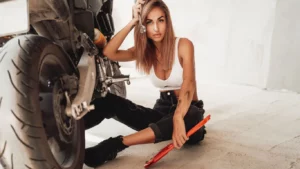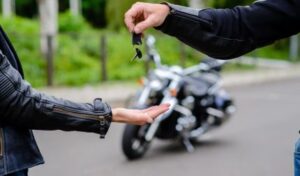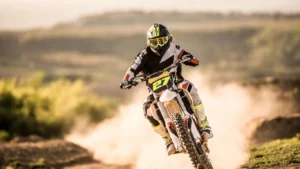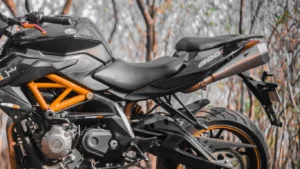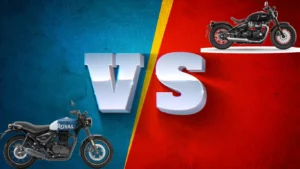If your motorcycle has been sitting idle for months or even years, don’t despair! You can bring your old bike back to life with the right steps. This guide will show you how to revive your motorcycle and make it shine like new. It doesn’t matter if it’s a classic or a newer model, we’ve got you covered.
Get ready to feel the excitement of riding your bike again. You’ll rediscover the joy of hitting the open road. Let’s get started on making your motorcycle rideable once more.

Key Takeaways
- Discover proven strategies to revive an idle motorcycle
- Learn how to assess the condition of your motorcycle and create a restoration plan
- Understand the essential steps to overhaul the engine, electrical system, and fuel system
- Explore techniques for restoring the bodywork, brakes, and suspension
- Discover maintenance tips to keep your revived motorcycle in top shape
Preparing for the Restoration Journey
The journey of restoring a classic motorcycle starts with preparation. Before you begin the motorcycle restoration, gather tools and supplies. Also, check your bike’s condition. This step is crucial for a successful motorcycle refurbishment project.
Gathering Essential Tools and Supplies
Having the right tools and supplies is vital for a motorcycle project. Start with a toolkit that has wrenches, sockets, pliers, screwdrivers, and a torque wrench. Don’t forget cleaning supplies, lubricants, and specialty parts for the reviving an old bike process.
- Wrenches, sockets, and pliers
- Screwdrivers (flathead and Phillips)
- Torque wrench
- Cleaning supplies (degreaser, rags, brushes)
- Lubricants (oil, grease, chain lube)
- Specialty parts (gaskets, seals, bearings)
Assessing the Motorcycle’s Condition
Before starting the motorcycle restoration, check your bike’s condition. This helps you understand the work needed and plan your steps. Look at the engine, electrical system, fuel system, brakes, suspension, and bodywork for any problems.
“The key to a successful motorcycle refurbishment is to have a clear understanding of the bike’s condition from the start.”
By preparing and gathering what you need, you’re ready to revive an old bike and make it shine again.
Overhauling the Engine
Restoring a motorcycle that has been sitting for a long time needs careful attention to the engine. The engine is the core of your motorcycle restoration project. It’s vital to make sure it’s in top shape to revive your old bike. Whether you’re working on a motorcycle refurbishment or a vintage motorcycle project, the engine overhaul steps are the same.
To start the engine overhaul, first inspect it for any wear or damage. Look at the cylinders, piston rings, crankshaft, and other key parts. If you find any worn or damaged parts, replace them to ensure the engine runs well.
- Disassemble the engine: Carefully take apart the engine, noting the order and orientation of parts for easier reassembly.
- Clean and inspect: Clean all engine parts, removing grime or debris. Check each part for wear or damage, and replace any that can’t be fixed.
- Rebuild the engine: After cleaning and inspecting, start rebuilding the engine. This may involve replacing bearings, seals, and other essential parts.
- Reassemble the engine: Reassemble the engine carefully, making sure all parts are aligned and tightened correctly.
- Test the engine: After reassembly, test the engine to make sure it’s running smoothly and has the right power output.
| Engine Component | Condition | Recommended Action |
|---|---|---|
| Cylinders | Worn, scored, or pitted | Rebore or replace |
| Piston Rings | Worn or broken | Replace |
| Crankshaft | Worn or damaged | Regrind or replace |
| Camshaft | Worn lobes | Replace |
By following these steps, you can bring a motorcycle back to life and restore a classic motorcycle to its former glory. Remember, the engine is the heart of your bike. Spending time and effort on the engine overhaul will make your motorcycle restoration project a success.
Reviving the Electrical System
Restoring a motorcycle that has been sitting for a long time needs careful attention to the electrical system. This part is key for a bike to work well. We’ll look at how to check and replace wiring and how to fix the battery.
Inspecting and Replacing Wiring
The first thing to do is check the wiring. Wires can get old, break, or rust, which can mess up the electrical system. Look closely at each wire for any damage or wear. If you find any problems, it’s best to replace the wires for safety and reliability.
Checking and Reconditioning the Battery
The battery is the heart of the electrical system. It gives the power needed to start the bike and keep it running. If the bike has been sitting for a while, the battery might be weak or old. Start by checking the battery’s voltage and condition.
If the battery is still good, clean the terminals and make sure it’s connected right. But if it’s too far gone, get a new, high-quality battery. This will help restore a classic motorcycle to its best state.
| Task | Importance | Difficulty Level |
|---|---|---|
| Inspecting and Replacing Wiring | High | Moderate |
| Checking and Reconditioning the Battery | High | Easy |
By focusing on the electrical system in your motorcycle restoration project, you’ll make sure the bike has a steady power supply. This is the first step to a successful reviving an old bike project.
Restoring the Fuel System
When you’re bringing an old motorcycle back to life, the fuel system is key. Ignoring it can cause big problems later. But, with the right steps, you can make your bike’s fuel system work like new again.
Start by checking the fuel tank. Old fuel and rust can harm it, blocking lines and clogging the carburetor. Drain the old fuel and clean the tank with a special cleaner or bead-blasting. If the tank is too damaged, get a new or used one.
- Look over and clean the fuel lines: Check for cracks, leaks, or blockages. Replace any lines that are worn or damaged to keep fuel flowing smoothly.
- Fix the carburetor: If your bike’s carburetor is old or damaged, take it apart, clean it, and put it back together. This ensures your engine gets the right amount of fuel.
- Get a new fuel filter: A dirty or old fuel filter can slow down fuel flow and hurt your bike’s performance. Swap it out for a fresh, high-quality one to keep fuel clean.
By carefully fixing the fuel system, you’re making a big step towards getting your vintage motorcycle running well again. This careful work will help your bike run smoothly and reliably. You’ll be able to enjoy riding your restored classic with confidence.
| Component | Restoration Procedure |
|---|---|
| Fuel Tank | Drain old fuel, clean interior, and replace if severely damaged |
| Fuel Lines | Inspect for cracks, leaks, or blockages, and replace as needed |
| Carburetor | Disassemble, clean, and rebuild for proper fuel delivery |
| Fuel Filter | Replace with a new, high-quality filter to maintain a clean fuel supply |
By spending time on your motorcycle’s fuel system, you’re on the path to reviving your bike. A clean, reliable fuel system means your bike will run smoothly and consistently. You’ll enjoy the thrill of riding your classic motorcycle again.
how to restore a motorcycle that has been sitting
Restoring a motorcycle that’s been sitting for a while can seem tough. But, with the right steps and effort, you can make your old bike new again. We’ll guide you through the process to revive a motorcycle that has been sitting and get it back on the road.
First, check the bike’s condition. Look for corrosion, dried-out seals, or stale fuel. Knowing what needs fixing helps in the restoration.
- Drain and replace the old fuel with fresh, high-quality gasoline. Stale fuel can clog the fuel system.
- Inspect and clean the carburetor(s) for proper fuel flow and air-fuel mixture. Rebuild if needed.
- Replace the spark plugs and check the ignition system. Worn parts can stop the engine from starting right.
- Lubricate all moving parts to prevent damage and ensure smooth operation.
- Check the tires and replace them if they’re cracked or worn. Proper tire pressure is key for safe riding.
By focusing on these key areas, you’re on the path to reviving an old bike and restoring a classic motorcycle. Take your time, work carefully, and always prioritize safety during the motorcycle refurbishment process.
| Task | Importance | Difficulty Level |
|---|---|---|
| Fuel System Overhaul | High | Moderate |
| Carburetor Cleaning/Rebuild | High | Moderate |
| Ignition System Inspection | High | Low |
| Lubrication and Maintenance | High | Low |
| Tire Replacement | High | Low |
By following these steps, you’re on your way to bringing a motorcycle back to life and restoring a classic motorcycle that’s been sitting for a while. Next, we’ll explore reviving the electrical system and other important parts.
Resurrecting the Brakes and Suspension
Starting your motorcycle restoration journey means focusing on the brakes and suspension. These parts are key to your safety and the bike’s performance. Let’s explore how to check, service, and refresh these critical systems.
Inspecting and Servicing Brake Components
Your classic motorcycle’s brakes need to be in perfect shape for safe stops. Begin by examining each brake part, like calipers, pads, discs, and lines. Look for wear, damage, or rust, and swap out any parts that aren’t safe.
After checking the brakes, it’s time to give them a service. Clean the brake fluid, wash the parts, and adjust the brakes for better performance. You might need to rebuild or replace the calipers to get them working right.
Checking and Replacing Suspension Parts
- Look over the suspension forks for leaks, pitting, or seal damage.
- Test the shock absorbers for rebound and compression, and swap them out if they’re not working well.
- Make sure the swingarm pivots and suspension linkages are in good shape, with no excessive wear.
- Replace any worn or damaged suspension parts to improve the ride’s smoothness and comfort.
By carefully fixing the brakes and suspension, you’re on the path to a fully restored motorcycle. This ensures a safe and fun ride.

“Attention to detail is the key to a successful motorcycle restoration. Take the time to inspect and service every component to ensure your bike is roadworthy and ready to ride.”
Breathing New Life into the Bodywork
Restoring an old motorcycle’s bodywork is key to its look. Whether you’re how to restore a motorcycle that has been sitting, reviving an old bike, or restoring a classic motorcycle, fixing dents, rust, and faded paint makes a big difference.
Repairing Dents and Rust
Start by fixing dents and rust. Check the frame, fuel tank, and panels for damage. Use a dent puller or body filler for small dents. For bigger issues, a motorcycle restoration expert might be needed.
Then, tackle rust. It can spread fast, so act quickly. Sand off the rust, apply a rust-inhibiting primer, and repaint to stop it from coming back.
Reviving the Paint Job
After fixing the bodywork and rust, it’s time for the paint. Motorcycle refurbishment often means bringing back the bike’s original color. Clean the surfaces well, then prime them for new paint.
Choose a paint color that matches the bike’s original look or adds a new twist. Paint in thin layers, letting each dry before adding more. Finish with a clear coat for a glossy look.
Fixing dents, rust, and paint brings your motorcycle back to life. With care and detail, your resurrected vintage motorcycle will look great on the road.
Finalizing the Restoration
Congratulations! You’ve reached the end of your motorcycle restoration journey. You’ve fixed the engine, electrical system, and fuel system. Now, it’s time to add the final touches to your classic motorcycle.
Start by carefully putting the motorcycle back together. Make sure each part is in its right place and tightened correctly. Paying attention to details is crucial to avoid any mistakes.
After reassembling, do a detailed check of the motorcycle. Test the brakes, suspension, and electrical systems. This ensures everything works right before you take it for a ride.
Once you’re happy with the inspection, it’s time for the test ride. Take your revived old bike for a spin. This is your chance to see if all your hard work paid off.
“Restoring a classic motorcycle is a labor of love, but the joy of bringing it back to life is truly unparalleled.”
After the test ride and any needed adjustments, your motorcycle restoration is complete. You can now show off your resurrected vintage motorcycle. Keep it in good shape with regular care to enjoy it for many years.

Maintaining Your Revived Motorcycle
Congratulations on your successful motorcycle restoration project! But, the journey doesn’t end there. Keeping your bike in top shape is key to its performance and life. Let’s explore the essential maintenance practices to keep your classic or vintage motorcycle in great condition for years.
Regular Maintenance Schedules
Creating a consistent maintenance schedule is vital for your motorcycle restoration. Regular services like oil changes, filter replacements, and tune-ups keep your bike running smoothly. Consider making a maintenance log to track your bike’s history and stay on top of tasks.
| Maintenance Task | Recommended Frequency |
|---|---|
| Oil Change | Every 3-6 months or 3,000-5,000 miles |
| Air Filter Replacement | Every 12 months or 12,000 miles |
| Spark Plug Replacement | Every 12-24 months or 12,000-24,000 miles |
| Brake Fluid Flush | Every 12-24 months |
Proper Storage Practices
When not in use, proper motorcycle storage is key. Store your motorcycle in a clean, dry, and controlled environment, like a garage or storage unit. If outdoor storage is needed, use a high-quality cover to protect it from the elements.
- Clean and lubricate the bike before storage
- Inflate tires to the recommended PSI
- Disconnect the battery and store it in a cool, dry place
- Avoid leaving the fuel tank full during long-term storage
- Periodically start the engine and take the bike for a short ride to prevent seizing
By following these maintenance and storage tips, your revived motorcycle will stay in top condition. It will be ready to provide you with years of enjoyment and adventure.
Conclusion
As we wrap up this guide, you now know how to make your old motorcycle shine again. You’ve learned the steps to motorcycle restoration. This includes reviving an old bike and bringing a vintage motorcycle back to life.
You’ve gone through everything from checking the bike’s condition to fixing the engine and electrical system. You’ve also learned how to restore the bodywork. This journey has given you the skills and confidence to work on any motorcycle project.
Your revived, rejuvenated motorcycle is now ready for the road. The excitement of riding your classic motorcycle again is here. Enjoy the freedom and the joy of bringing a motorcycle back to life. Your hard work and skills will pay off as you hit the open road with your restored motorcycle.
FAQ
What tools and supplies do I need for a motorcycle restoration project?
To restore a motorcycle, you’ll need various tools and supplies. This includes basic hand tools like wrenches, sockets, and screwdrivers. You’ll also need specialty items like a torque wrench, wire crimpers, and a parts cleaning station. Having a well-equipped workshop or garage is also essential.
How do I assess the condition of my motorcycle before starting the restoration?
Before starting, inspect your motorcycle carefully. Look for any damage, rust, or wear on the frame, engine, and other major parts. Also, test the electrical, fuel, and brake systems to find any issues to fix during the restoration.
What are the key steps in overhauling the engine during a motorcycle restoration?
Overhauling the engine is a key part of the restoration. You’ll need to disassemble the engine, inspect parts, clean and replace worn ones, and then reassemble it. This ensures the engine works well and reliably.
How do I revive the electrical system on a motorcycle that has been sitting?
To revive the electrical system, check and replace damaged or corroded wiring. Also, test and condition the battery for a steady power supply. This is vital for the motorcycle’s functionality and safety.
What should I do to restore the fuel system on a motorcycle that has been idle for a long time?
When restoring a long-idle motorcycle, the fuel system needs attention. Clean or replace fuel lines, flush the fuel tank, and fix any fuel pump or carburetor issues. This ensures the fuel system works right.
How do I address issues related to a motorcycle that has been sitting for an extended period?
Restoring a long-sitting motorcycle requires special care. Clean the fuel system, replace corroded parts, and lubricate and condition neglected components. This tackles problems like stale fuel and corrosion.
What are the important steps in restoring the brakes and suspension on a motorcycle?
Restoring brakes and suspension is crucial for safety and performance. Inspect and service brake components and check and replace worn suspension parts. This ensures a smooth and reliable ride.
How can I breathe new life into the bodywork of my restored motorcycle?
Restoring the bodywork enhances your motorcycle’s look. Repair dents or rust and revive the paint job for a fresh look. Paying attention to these details greatly improves your bike’s appearance.
What are the final steps in completing a successful motorcycle restoration project?
After major restoration tasks, reassemble the motorcycle and do a thorough inspection. Test all systems, make adjustments, and take it for a test ride. This ensures a smooth and reliable ride.
How do I maintain my restored motorcycle to keep it in top condition?
Maintaining your restored motorcycle is key to its performance and longevity. Follow regular maintenance schedules, like oil changes and inspections. Also, store your bike properly when not in use.

